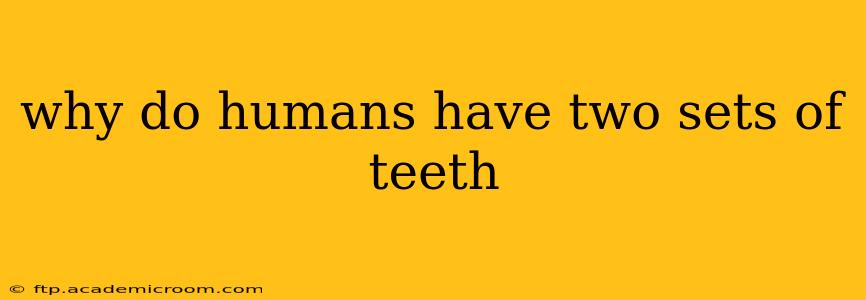Humans, along with many other mammals, are diphyodonts – meaning we develop two sets of teeth in our lifetime: deciduous teeth (also known as baby teeth, milk teeth, or primary teeth) and permanent teeth (also known as adult teeth or secondary teeth). But why this two-stage dental development? The answer is multifaceted, involving evolutionary advantages and developmental complexities.
What are the Advantages of Having Two Sets of Teeth?
The evolution of diphyodonty offers several key benefits:
-
Space Management: The jaw of a growing child is much smaller than that of an adult. The smaller deciduous teeth perfectly fit into this smaller jaw, allowing for proper chewing and development. As the jaw grows, the larger permanent teeth replace the deciduous teeth, ensuring proper alignment and function in the adult dentition.
-
Evolutionary Adaptation: Diphyodonty likely evolved as an adaptation to the changing dietary needs of mammals throughout their life cycle. Baby teeth are suited to the softer foods eaten during infancy and childhood, while permanent teeth are designed to handle the more varied and often tougher foods consumed in adulthood.
-
Jaw Development: The presence and shedding of deciduous teeth play a critical role in the development and growth of the jaw bones. The roots of the baby teeth help stimulate the growth and proper shaping of the jaw, creating the space needed for the larger permanent teeth to erupt.
-
Reduced Risk of Dental Trauma: The presence of two sets of teeth may have also provided an evolutionary advantage by offering a "backup" set in case of tooth loss during childhood. The temporary nature of the primary teeth means that damage or loss can be less problematic, as they will be replaced.
What is the Timing of Tooth Eruption?
The eruption of teeth follows a relatively predictable pattern, although some variation exists. Deciduous teeth typically begin to emerge around six months of age and continue to erupt until about two to three years old. Permanent teeth then begin to replace the deciduous teeth, usually starting around age six and continuing until approximately age 12-13. The third molars (wisdom teeth) are the last to erupt, often appearing between ages 17 and 25, or not at all.
How Long Do Baby Teeth Last?
Baby teeth generally last until they are naturally replaced by permanent teeth. This replacement process usually begins around age six and continues until around age 12 or 13. Each tooth is shed individually, and the timing can vary slightly between children.
When Do Adult Teeth Come In?
Adult teeth begin erupting around age six with the first molars and incisors typically emerging first. The process continues gradually over many years, with the final molars (wisdom teeth) often appearing in the late teens or early twenties (or not at all).
Why Do Some People Have Fewer Teeth?
Variations in the number of teeth can occur due to genetic factors, developmental issues, or other medical conditions. Some individuals may be born with fewer than the usual number of teeth (hypodontia), while others may have extra teeth (hyperdontia). These conditions can influence the timing and sequence of tooth eruption.
Why Do Wisdom Teeth Often Need Removal?
Wisdom teeth often require removal because the modern human jaw is often too small to accommodate them properly. This can lead to impacted wisdom teeth, which are teeth that are partially or fully trapped beneath the gum line or bone. Impacted wisdom teeth can cause pain, infection, and damage to adjacent teeth, hence the frequent recommendation for their removal.
Understanding the reasons behind the evolution and development of two sets of teeth provides a fascinating glimpse into the complexities of human biology and adaptation. The system, while generally efficient, highlights the intricate interplay between genetics, development, and environmental factors in shaping our oral anatomy.
